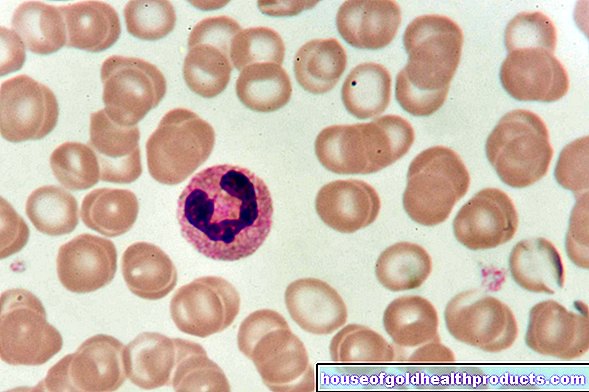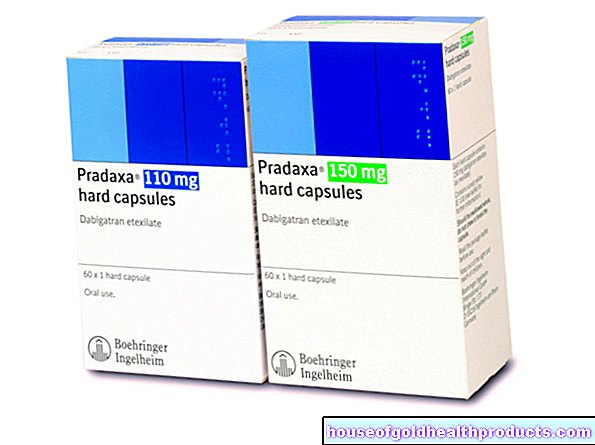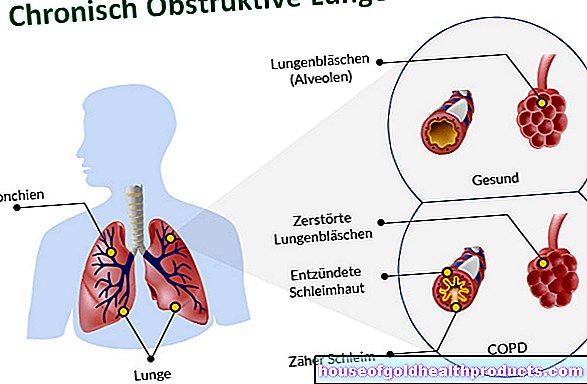Pituitary adenoma
Ricarda Schwarz studied medicine in Würzburg, where she also completed her doctorate. After a wide range of tasks in practical medical training (PJ) in Flensburg, Hamburg and New Zealand, she is now working in neuroradiology and radiology at the Tübingen University Hospital.
More about the experts All content is checked by medical journalists.Pituitary adenoma is a rare, benign tumor of the pituitary gland in the head. It can occur at any age. The causes are so far largely unknown. A pituitary adenoma can cause various hormonal disorders, but also headaches and visual disturbances. With proper treatment, the prognosis is usually good. Here you can read everything you need to know about pituitary adenoma.
ICD codes for this disease: ICD codes are internationally recognized codes for medical diagnoses. They can be found, for example, in doctor's letters or on certificates of incapacity for work. D43C71D33

Pituitary adenoma: description
Pituitary adenoma is a rare, benign tumor of the pituitary gland (pituitary gland) in the skull. It makes up about 15 percent of all brain tumors. The disease can occur at any age, but it is usually diagnosed between the ages of 35 and 45.
The pituitary adenoma grows in the so-called Turkish saddle (Sella turcica). This is a bony hollow in the anterior base of the skull in which the pituitary gland is located. The optic nerves cross in the immediate vicinity. The hypothalamus, the control center of the pituitary gland, is also located here. When a pituitary tumor causes symptoms, it is mostly due to the displacement of neighboring brain structures.
Forms of pituitary adenoma
The pituitary gland produces different messenger substances (hormones) with the help of different gland cells. A pituitary adenoma can in principle arise from any of these different gland cells and subsequently cause an overproduction of the hormone in question. Around 60 percent of all patients have such an endocrine-disrupting pituitary adenoma:
In about 30 percent of cases, the hormone prolactin, which promotes breast milk, is increased. This pituitary tumor is known as a prolactinoma. The growth hormone is released somewhat less frequently, at around 20 percent. In about five percent of the cases, the adrenocorticotropic hormone (ACTH) is affected by the overproduction. Very rarely, pituitary adenoma affects the production of thyroid and sex hormones.
In addition to these endocrine-disrupting tumors, there are also those that do not affect hormone production. In about 40 percent of all patients with a pituitary adenoma, the pituitary adenoma remains endocrine disrupted.
Pituitary adenoma: symptoms
Not infrequently, years pass before a pituitary tumor causes symptoms because it grows very slowly. Although it is basically a benign tumor, the pituitary adenoma can trigger dangerous symptoms due to its location in the skull - either because the tumor presses on neighboring brain structures or because it disrupts hormone metabolism.
General symptoms of brain tumor such as headache, nausea, vomiting, muscle paralysis and a head of water usually only occur with a large pituitary adenoma.
If the pituitary adenoma presses on the optic nerves, visual disturbances develop. Often the outer visual fields fail first. Some people have blurred or double vision. With a pituitary adenoma, however, such visual problems do not have to be continuous. They can also change and appear differently strong. Larger tumors can even cause those affected to go blind. The pituitary gland (pituitary gland) can produce six different hormones in response to signals from its superordinate center (hypothalamus). These stimulate other hormonal glands in the body (such as the thyroid or adrenal gland) to produce hormones in turn. This enables the hypothalamus and pituitary gland to regulate the release of various hormones in the body.
Pituitary adenoma can affect the functioning of the hypothalamus or pituitary gland. Then too many or too few hormones may be produced. Therefore, different complaints can arise. Although the cause of all these complaints is a pituitary adenoma, some clinical pictures have their own name, such as prolactinoma, acromegaly and Cushing's disease (see below).
Prolactin and sex hormones
The hormone prolactin is particularly important during pregnancy and breastfeeding. It is created in the pituitary gland and ensures that the breast produces milk. If a pituitary adenoma produces increased prolactin, it is called a prolactinoma. Women can then have a milk leak even without pregnancy. In men with a prolactinoma, the breast grows and looks more feminine.
In addition, the female (estrogens) and male (testosterone) sex hormones can be affected by a prolactinoma or other pituitary tumor. In women, the menstrual period can be irregular or even stop altogether. For some, physical pleasure (libido) diminishes. Men sometimes have problems building an erection (loss of potency).
Growth hormones
The growth hormone from the pituitary gland is not only important for the body growth and development of children. In adults, too, it controls important body functions such as bone, fat and muscle metabolism. If too much growth hormone is produced by a pituitary adenoma, the body will grow. In the case of children in the growth phase, one speaks of large stature (gigantism). In adults, on the other hand, most of the bone growth plates are already closed. With a growth hormone-producing pituitary adenoma, especially the hands and feet enlarge and the facial features become coarser (acromegaly). As the jaw grows, the teeth move apart. In addition, those affected often sweat more. In some people, a hand nerve becomes pinched (carpal tunnel syndrome), which causes pain.
A pituitary adenoma can also prevent growth hormones from being released. Those affected then often feel less productive. Their fat metabolism can be disturbed, so that they store more fat, especially on the stomach. Blood lipid levels can also be increased. Often less calcium is stored in the bones. This can reduce bone density (osteoporosis).
Adrenal cortex hormones
The pituitary gland also stimulates the adrenal gland with the control hormone adrenocorticotropic hormone (ACTH). This can release korstisol (a stress hormone), aldosterone (a hormone for the salt and water balance) and sex hormones. If a pituitary adenoma disrupts this hormone production, complex processes in the body can be changed - especially the metabolism of fat, bones, sugar, salt and fluid.
If a pituitary adenoma produces too much ACTH, Cushing's disease develops. Signs of illness are overweight (obesity), a full moon face, stretch marks on the upper body, high blood pressure, diabetes (diabetes mellitus), osteoporosis, water retention in the tissue (edema), depression and anxiety.
If, on the other hand, a pituitary adenoma suppresses ACTH production, weakness, fatigue, weight loss, nausea and vomiting occur.
Thyroid hormones
A pituitary adenoma rarely changes thyroid function. The thyroid hormone thyroxine has an effect similar to gasoline for a car. It drives many organs and gets the body going. If it is produced in excess due to a pituitary adenoma, the heart beats faster than normal, you sweat, and the bowel works harder. Diarrhea and fever can occur.
If, on the other hand, too few thyroid hormones are produced by a pituitary adenoma, many metabolic processes freeze. Affected people are cold, constipated, tired and lacking motivation.
Antidiuretic hormone
The antidiuretic hormone (ADH) controls the fluid balance in the body. It ensures that not too much water is lost through the urine. In doing so, it also affects the concentration of blood salts and blood pressure. ADH is formed by the hypothalamus, stored in the pituitary gland and released from there when needed.
Pituitary adenoma can affect ADH metabolism. If too little ADH is released, those affected suffer from diabetes insipidus: They excrete many liters of water-clear urine. In order not to dehydrate, they have to drink a lot.
Pituitary adenoma: causes and risk factors
A pituitary adenoma can develop when individual gland cells in the pituitary gland degenerate and begin to grow in an uncontrolled manner. Why this happens has not yet been clarified.
In some patients, pituitary adenoma develops as part of multiple endocrine neoplasia (MEN1). This is an inheritable clinical picture in which several hormonal glands are pathologically changed due to a genetic defect.
Pituitary adenoma: examinations and diagnosis
If a pituitary adenoma is suspected, doctors from different disciplines work together to obtain certainty:
Radiologists use magnetic resonance imaging (MRI) or computed tomography (CT) to produce images of the head. They can then see whether there is actually a tumor and where exactly it is. The tumor size and any calcifications can also be seen in imaging procedures. The neurologist (neurologist) examines the patient if muscle paralysis or headaches occur. If there are visual disturbances, an ophthalmologist is usually consulted.
Endocrinologists are particularly important in the case of a pituitary adenoma. You can describe the patient's complaints and consider whether a certain hormonal cycle could be impaired. They can measure the individual hormone concentrations and other parameters that are important in a pituitary adenoma in the patient's blood, saliva and urine. This is how they find out which endocrine gland is impaired. Even after treatment, people with pituitary adenoma are regularly examined by endocrinologists.
A pituitary adenoma often causes very unspecific symptoms that can also be assigned to other diseases. Because of this, in many cases it takes a long time before the correct diagnosis can be made.
Pituitary adenoma: treatment
If pituitary adenoma does not cause symptoms, it does not necessarily need to be treated. Then, usually at certain time intervals, an imaging examination is used to check whether the tumor is growing and whether treatment may then be necessary.
Which therapy is suitable for a pituitary adenoma is usually decided on an individual basis. As a rule, all doctors involved discuss with the person affected which treatment is most useful. In principle, a pituitary adenoma can be operated on, irradiated and treated with medication.
Pituitary adenoma: surgery
During an operation, surgeons try to remove the pituitary adenoma as completely as possible. The special thing about this operation is that it can often be performed through the nose. This means that you will not see a scar on your head after the operation. Larger tumors may first have to be reduced in size with radiation therapy.
During an operation, surrounding structures such as vessels, nerves or the pituitary gland itself can be injured, which can then make further therapeutic measures necessary.
Examination and treatment
You can read more information about examinations and treatment in the article Brain Tumor.
Pituitary adenoma: drug treatment
Not all patients with pituitary adenoma require surgery. Hormone-producing pituitary tumors such as the prolactinoma can in some cases be treated well with medication. In addition, drug therapy is often used before the operation and when a hormonal cycle is permanently damaged after the treatment. ADH, thyroid, growth, sex and stress hormones can be replaced with medication if they are deficient. However, since the hormones are formed and released in different amounts during the course of the day and depending on the respective phase of life, this hormone replacement therapy is not that easy. In order to optimally set the dose, various values in the body have to be determined, sometimes at different times of the day. In certain situations (such as stress or infections), those affected have to take more or less medication than usual. Hormone therapy must therefore be monitored regularly by the doctor.
Pituitary adenoma: disease course and prognosis
The course of the disease and the prognosis of a pituitary adenoma depend crucially on when it is discovered and treated. With timely therapy, the prognosis is very good. Some patients can be completely cured, others must take hormones for life. Long-term changes in hormones can damage many different organs in the body. Undetected hormonal imbalances caused by a pituitary adenoma can even be fatal.
Tags: hospital magazine skin





























